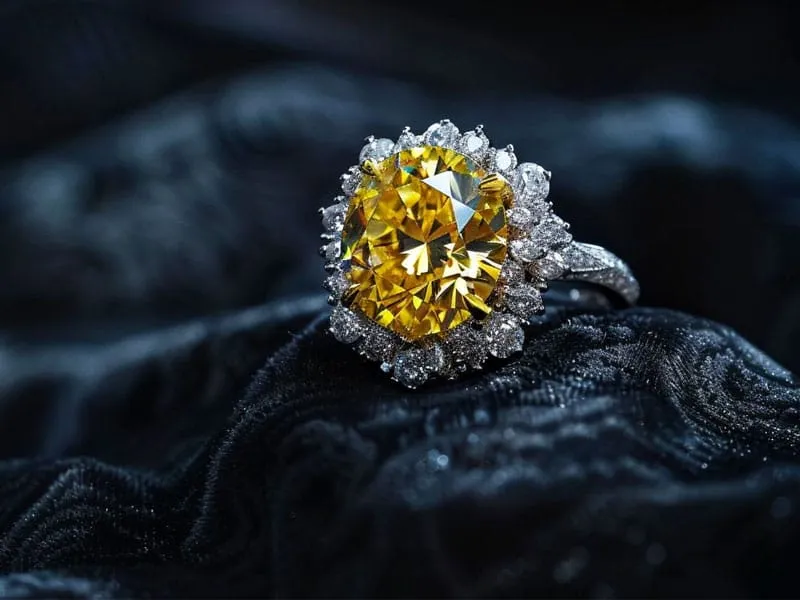
The Ultimate Guide To Yellow Diamonds – Beautiful Canary Gems
Looking for that perfect stone for your engagement ring but want something different?
Yellow diamonds offer a splash of color while keeping the elegance.
This article shines a light on these canary gems, from their radiant cuts to their rare origins.
Key Takeaways
- Yellow diamonds are rare gems that get their color from nitrogen mixing with carbon crystals during formation.
- They come in various shades, including canary yellow and fancy vivid yellow, graded by the Gemological Institute of America (GIA).
- These diamonds originate from a few places around the world, like Australia’s Argyle mine and South Africa’s mines.
- Yellow diamonds undergo treatments to enhance or change their color, including High Temperature and High Pressure (HTHP) treatment.
- Popular cuts for yellow diamonds include radiant cut, cushion cut, and pear shape which highlight their unique colors and sparkle.
What Are Yellow Diamonds?
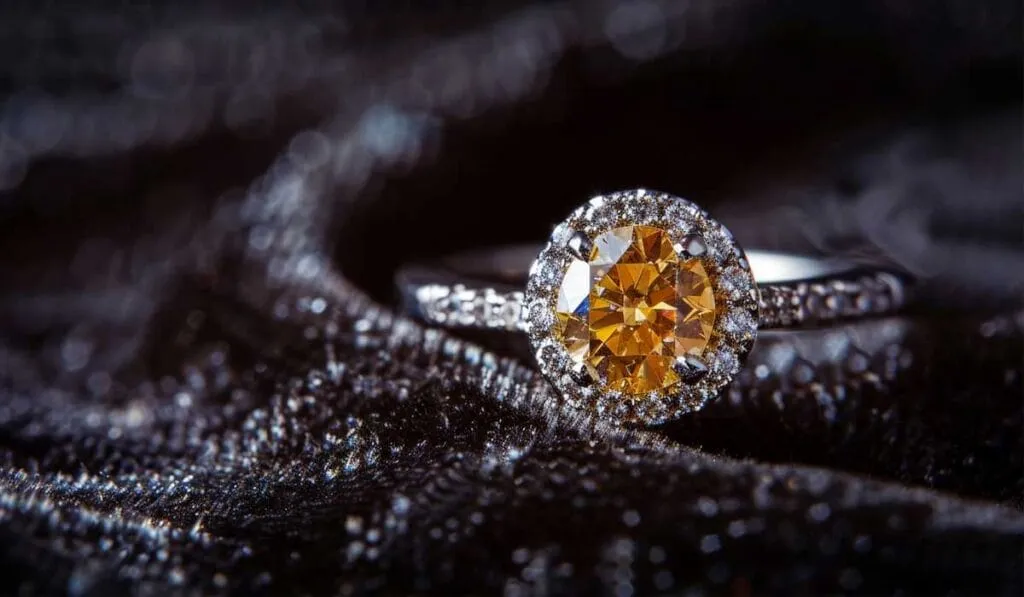
Yellow diamonds are like the sun’s rays captured in stone. They get their cheerful color from nitrogen atoms mingling with carbon crystals during formation.
Definition and General Characteristics
Yellow diamonds shine bright like the sun, bringing a splash of color to any piece of jewelry. These gems stand out because they have something special – their fancy color that captures everyone’s attention.
Think of them as the stars in the night sky; while most diamonds are white or clear, yellow ones sparkle with a unique light. This rarity is due to nitrogen molecules that get cozy with carbon crystals during formation deep within the Earth’s crust.
It’s like a secret recipe that nature uses to cook up these beautiful stones.
They come in various shades, from fancy light yellow to fancy vivid yellow, each telling its own story through brilliance and hue.
Picture slicing into different layers of cake – each layer has its own flavor and color intensity; it’s similar with yellow diamonds.
The Gemological Institute of America (GIA) plays matchmaker by grading these hues, ensuring every diamond gets the recognition it deserves.
Whether set in engagement rings or necklaces, these colored diamonds make hearts skip a beat with their unmatched glow and elegance.
The Science Behind the Color
Diamonds get their colors from the tiny bits and pieces that mix in during their creation under the earth. Yellow diamonds, often called canary gems, have a special twist to their tale.
They owe their sunny hue to the presence of nitrogen molecules that absorbed bits of blue light, leaving a luminous yellow glow. Think of it like mixing paints — add a bit of yellow to white, and you’ll end up with a warm shade; that’s essentially what nitrogen does in these precious stones.
During our visit to a diamond grading lab, we got up close with these fancy colored diamonds under various lights. It was fascinating to see how the intensity of color changed depending on the light source — sunlight made them shimmer brilliantly while artificial light brought out deeper hues.
The gemologists explained that assessing color for fancy intense yellow or other shades involves carefully observing under controlled lighting conditions because even slight variations make a big difference in value.
So next time you marvel at a sparkling piece of jewel set in yellow gold, just know there’s quite an intricate science behind its beauty.
The Various Shades of Yellow Diamonds
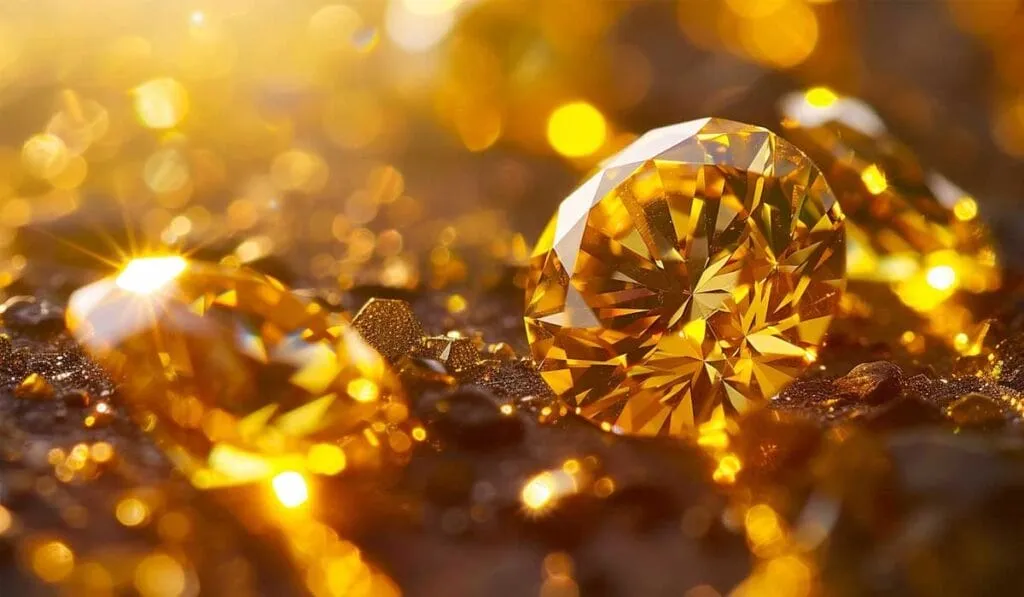
Yellow diamonds come in a rainbow of sunny shades, each with its own sparkle. From the light and bright canary yellow to the deep, intense fancy vivid hue, these gems have a color for everyone.
Canary Yellow
Canary yellow diamonds shine bright like the sun, capturing hearts with their radiant glow. These gems stand out with a color that reminds you of a canary bird—vivid and full of life.
They are part of the fancy color diamonds family, making them rare treasures in the gem world. Their sparkle is irresistible, turning heads wherever they go.
Crafting these gems into stunning pieces is an art. Jewelers often choose cuts that enhance their brightness even more—like round brilliant or cushion cut. A well-cut canary diamond reflects light beautifully, making its color pop against any setting, be it white gold or rose gold.
Fancy Light Yellow
Fancy Light Yellow diamonds are like the first rays of sunshine on a clear morning. They sparkle just enough to catch your eye but won’t blind you like their brighter cousins. This shade of yellow is softer, making it perfect for someone who loves the idea of colored gems but prefers a hint rather than a shout.
Think of them as introverts at a party—they’re definitely present and interesting, without being the center of attention.
These gems score lower on the diamond color grading scale because their color isn’t as deep. However, this doesn’t mean they lack beauty or value. With the right cut—perhaps an oval or radiant—their subtle hues come alive, dancing in light with every move.
Buyers often find fancy light yellow diamonds set in rings surrounded by smaller, colorless stones. This setting makes their gentle yellow stand out even more against the sparkle around them.
So while they might not scream luxury like a “fancy vivid” gem might, these diamonds whisper elegance and sophistication.
Fancy Intense Yellow
Stepping up from Fancy Light Yellow, we now look at Fancy Intense Yellow diamonds. These gems crank the saturation dial to show a deep, rich yellow that captures eyes from across the room.
Think of sunlight packed tightly into a crystal; that’s what these look like. Their color is so bold and bright, you almost need sunglasses to gaze at them.
I had the chance to hold one of these dazzlers once. Its facets—those tiny flat surfaces on diamonds—played with light like nothing else I’ve seen. It was as if each facet whispered secrets about capturing sunshine and joy.
And let me tell you, holding it felt more special than clasping onto a piece of starlight! In terms of cuts, radiant and cushion are top picks for showing off this intense yellow hue because they amplify its sparkle and depth.
Noteworthy, too, is their rarity in nature which makes every find a little treasure hunt victory.
Fancy Vivid Yellow
Fancy Vivid Yellow diamonds light up the room like no other gem can. They have a brightness that makes you think of sunshine packed into a stone. People often choose these sparklers because they stand out.
Their color is so deep and pure, it’s like looking into golden honey.
These gems go through a strict grading process. Color intensity is key here. The more vibrant, the better. This grade of yellow diamond sits at the top of its class for how vividly it shines.
Imagine cutting a radiant or cushion shape from this diamond—it would catch every eye in the room! Plus, when set in gold or contrasted with smaller colorless diamonds, their beauty really pops, making them perfect for those who love to stand out.
How Yellow Diamonds Are Graded
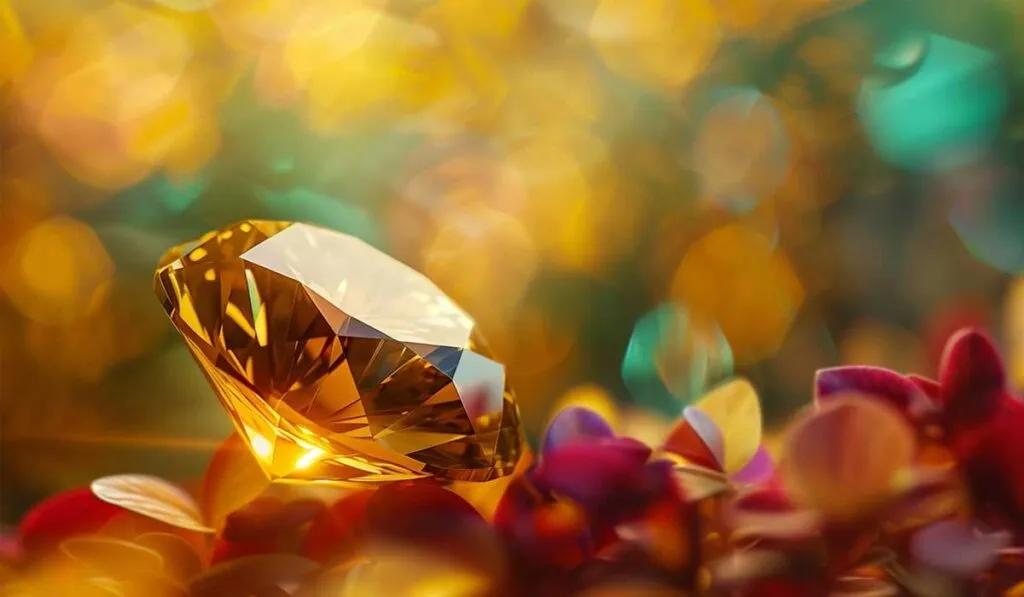
Grading yellow diamonds is like solving a colorful puzzle. Experts look at how deep the color is, from light to vivid. They also check for any marks inside and see if the diamond was cut well, making it sparkle just right.
Each piece gets its own score card that says how special it is. Dive in to discover more about these sunny stones!
Color Intensity Levels
Color intensity levels in yellow diamonds are like the volume knob on your favorite song – they control how bold and beautiful these gems appear. From a whisper of yellow to a shout, these levels range from Fancy Light to Fancy Vivid.
Think of them as the spice levels at your go-to taco spot; some people love a mild flavor that’s easy on the tongue, while others want that intense kick that makes their taste buds dance.
In diamond talk, more color means more rarity and often, a higher price tag.
Diamond experts use a special scale to decide where each gem falls. They look closely at each diamond under bright lights, comparing it to master stones set by leading gemological institutes.
This process is like finding the perfect match in a game of memory where only the sharpest eyes win. Diamonds with deeper hues are rarer than those with lighter tones, making them both more desirable and valuable.
So next time you’re admiring a stunning yellow diamond, keep in mind—it’s not just about size or shape but also about how its lively color sings out loud and clear.
Clarity and Its Impact
Transitioning from how we measure the intensity of a yellow diamond’s color, let’s shift our focus to clarity. Imagine clarity as a window into the essence of your diamond.
This gem quality is all about the little marks and features inside or on the surface, which can affect how light dances through it.
Clarity plays a huge role in bringing out that fiery sparkle we all love.
In the dance of buying a yellow diamond, think of clarity as one of your main steps. Even if a stone shines bright like sunshine because of its color, any visible imperfections could dull its shine.
Diamond cutters work magic with their tools to enhance its beauty and hide these tiny flaws from plain sight. So, keep this golden rule in mind: A clearer diamond means more eyes catching its gleam – making it not just a jewel but a piece to be admired by all who see it.
A flawless heart reflects light best.
The Importance of Cut and Shape
After looking at how clarity can make a big difference, let’s explore why the cut and shape of a yellow diamond matter so much. Think of these diamonds as celebrities dressed for the red carpet.
The cut is like their stylist—it brings out their best features. A well-chosen silhouette—be it an oval cut diamond or radiant—lets that sunny color shine in all its glory.
Now, imagine trying to fit a square peg into a round hole. That’s what it feels like when a magnificent hue gets trapped inside because of poor cutting techniques. I once had an emerald cut that did nothing for my gem until I switched to a pear shape.
Suddenly, light danced through every facet! Choosing between asscher, cushion, or hearts and arrows isn’t just about preference; it’s about revealing brilliance and fire within the stone.
So whether you’re leaning towards something traditional like baguettes or daring with an oval outline, just know—the right chop makes your yellow dazzler ready for its close-up!
Rarity and Origin of Yellow Diamonds
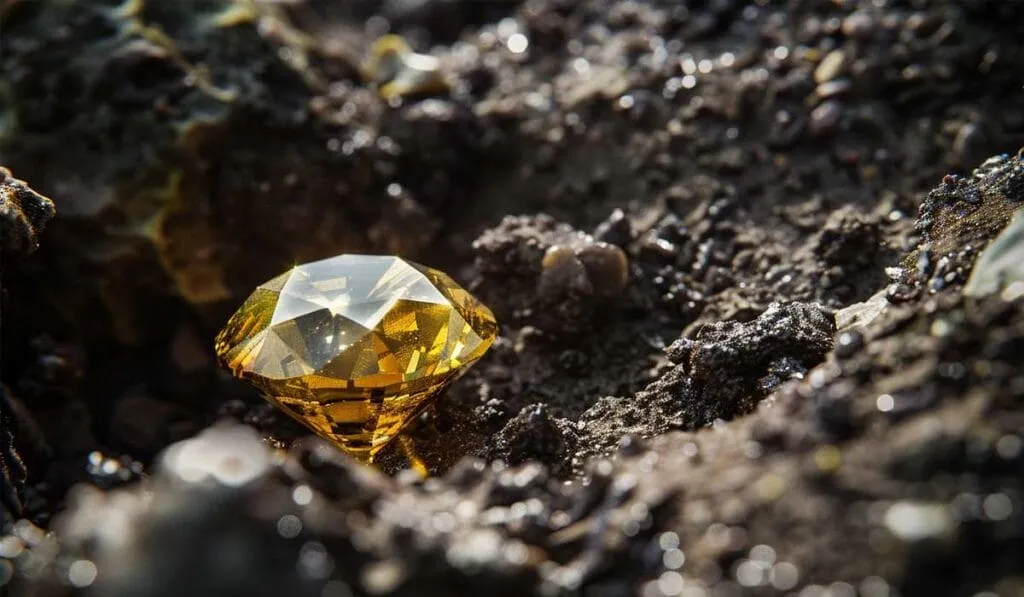
Yellow diamonds are like hidden treasures found in only a few corners of the world. From the deep mines of South Africa to the vast lands of Australia, these gems tell tales of journeys from beneath the earth to dazzling jewelry stores.
Geographic Sources
Yellow diamonds, those sparkly gems that catch your eye, come from a few special places around the globe. Think of it like this: just as you have favorite spots for finding the best coffee or the tastiest tacos, yellow diamonds too have their “happy places.”
Many of these gems start their journey in Australia, particularly at the Argyle mine—famous for its wide array of colored diamonds.
This mine is like a treasure chest but for earth’s natural beauties rather than gold or silver.
Venturing to South Africa, we find another rich source at mines like Venetia. Here, miners dig deep into the earth’s crust with tools and machinery that seem straight out of a science fiction movie.
Every so often, they uncover yellow gems that make jewelers and diamond lovers worldwide go wild with excitement. And let’s not forget Russia; amidst its vast landscapes lies the Mir mine where cold temperatures do nothing to dampen the warmth these sunny stones bring when they’re found glinting inside layers of rock and dirt.
Rarity Compared to Other Diamonds
Yellow diamonds stand out in a crowd, not just for their sunny hues but because they’re less common than your garden-variety colorless sparklers. Picture it like finding a four-leaf clover—special and rare.
Most diamonds pulled from the earth don’t have that eye-catching yellow; instead, they come out clear or with a slight brown tint. So when you lay eyes on a canary yellow gemstone, you know it’s not something you’ll see in every display case.
In the glittering world of gems, where sapphires and rubies grab headlines, yellow diamonds carve their own niche. They’re harder to find than many other colored stones too – more so than the widely loved pearls or even brown diamonds.
This scarcity ramps up their appeal among collectors and enthusiasts alike who are always on the hunt for something that stands apart from the norm. Plus, since most of these sun-kissed beauties hail from just a few spots around the globe—think Australia’s Argyle mine or South Africa’s mines—their rarity is also rooted in geography.
The Process of Creating Yellow Diamonds
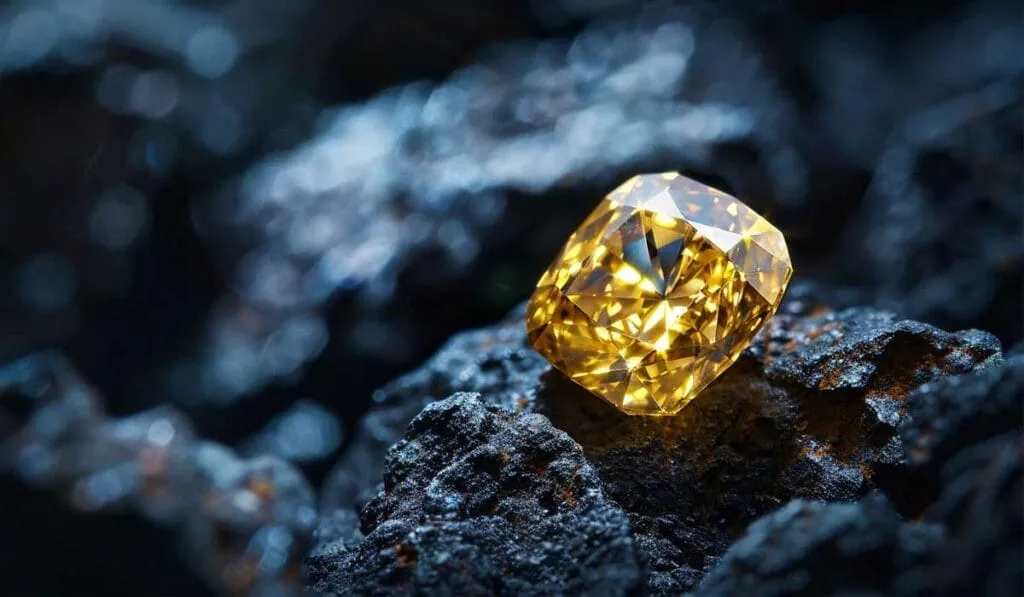
Yellow diamonds come to life deep within the Earth, where extreme heat and pressure work their magic. This natural process can take billions of years, kind of like cooking the perfect lasagna but way longer and definitely more impressive.
Natural Formation
Deep in the Earth, under immense pressure and heat, carbon atoms start dancing. They come together in a special way that only happens deep underground. This dance goes on for millions of years.
It’s not quick; it’s a slow groove that forms diamonds. Now, throw some nitrogen into the mix during this process, and voila! You get yellow diamonds born from the depths of our planet.
These gems have stories to tell—stories of time, heat, and transformation.
I once met a gemologist at a diamond trade conference who shared an insider story about finding these yellow beauties. He said finding a spot where natural forces have created yellow diamonds is like striking gold for them but much rarer.
He explained how these treasures travel from deep inside the Earth to reach us through volcanic eruptions—a journey as explosive as it sounds!
Every canary gem has trekked its own fiery path upwards until humans dig them up or stumble upon them while exploring new lands or old mines with hopes pinned on high-tech tools for clean mining practices today—they aim not just to find diamonds but to protect our blue planet too.
Treatments and Enhancements
Yellow diamonds shine bright, but sometimes they get a little help. Skilled gemologists use treatments and enhancements to boost their color and appeal. Here’s how they do it:
- High temperature and high pressure Treatment (HTHP) – Experts mimic the Earth’s natural conditions that create yellow diamonds. They use extreme heat and incredible pressure to enhance or change the diamond’s color.
- Coating – A thin film is applied to the diamond’s surface. This alters its color perception. Think of it like sunglasses for your gem, making the world see it in a different light.
- Laser Drilling – Microscopic lasers remove small inclusions inside the diamond. This process can improve both its clarity and color, making the yellow pop more.
- Irradiation followed by Heat Treatment – First, diamonds are blasted with electrons or neutrons to change their atomic structure, darkening them into a rich yellow. Heat is often used afterward to stabilize the new color.
- Annealing – By carefully heating and then slowly cooling the diamond, gemologists can subtly alter its hue, enhancing its yellow shade.
- Deep Boiling or Acid Washing – Dirt and debris trapped during the diamond’s journey from deep earth to surface can affect its color; cleaning it in boiling acid brings out a brighter yellow.
Each technique has its own way of bringing out the best in these sunny gems, ensuring they sparkle just right. Whether through intense pressure or a gentle heat, each process aims to make every yellow diamond catch the eye—and keep it there.
Comparing Yellow Diamonds
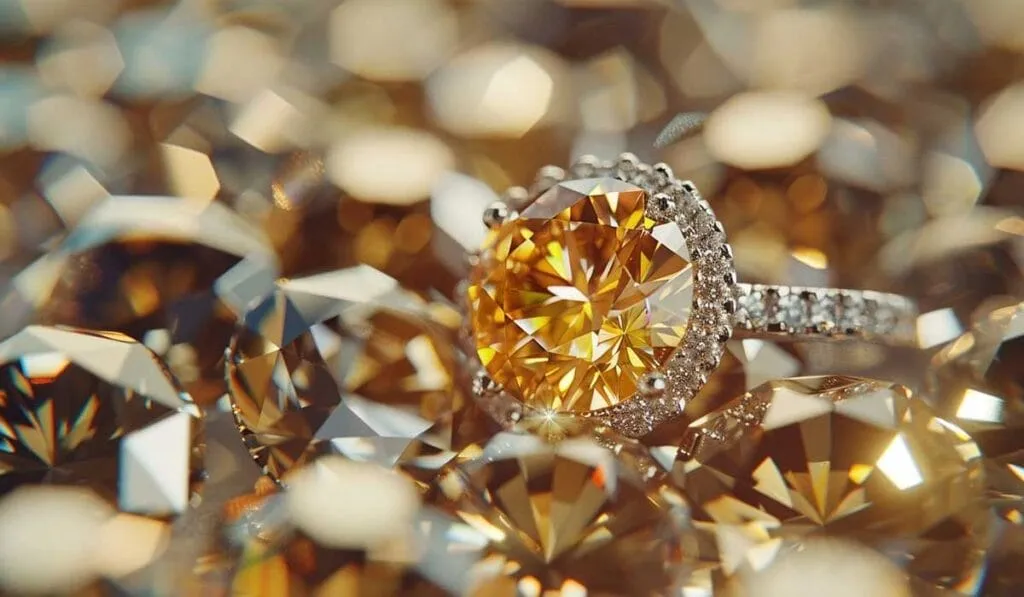
Yellow diamonds aren’t just another pretty rock. They stand toe-to-toe with the classic sparkle of colorless gems and offer a splash of sunshine compared to other colored stones.
Yellow vs. Colorless Diamonds
Colorless diamonds shine bright, like a ray of sunlight catching ice—classic and sparkling. They’re the go-to gem for many, celebrated for their purity and simplicity. Yet they stand on one side of a spectrum where color breathes life into brilliance.
Enter yellow diamonds, with hues ranging from gentle sunrise to bold canary. These gems carry warmth that colorless cannot, making hearts skip with their unique glow.
I once held both in my hand under the soft gleam of a jeweler’s lamp—colorless against yellow. The difference struck me not just visually but emotionally; the yellow diamond seemed to hold stories within its facets, while the colorless whispered elegance and tradition.
It’s more than just about choosing between vibrant or classic—it’s about feeling the energy each stone carries.
Yellow vs. Other Colored Diamonds
Yellow diamonds shine bright like the sun, but let’s talk about how they stand out in the colorful crowd. Unlike their colorless cousins that catch light and sparkle, yellow gems have a warm glow that reminds you of sunshine on a clear day.
These canary treasures are also rare birds compared to other colored rocks. Think rubies or sapphires—those guys show up more often at parties.
Now, if we’re comparing apples and oranges—or in this case, yellows with blues or pinks—yellow diamonds bring something special to the table…or ring setting. My own journey led me to choose a yellow over the more common blue because it just felt happier, like wearing a piece of sunshine.
And while every shade from fancy light to vivid has its charm, there’s something irresistible about how these sunny stones make you feel energized and radiant.
Plus, opting for yellow might just set your jewelry apart in a sea of traditional whites and expected hues—it’s all about making that bold statement without saying a word!
Popular Cuts for Yellow Diamonds
Yellow diamonds look their best when cut just right. Some shapes make them shine more than others.
Radiant Cut
Radiant cut diamonds sparkle like no other, combining the elegance of emerald cuts with the brilliance of round gems. Think of it as getting the best of both worlds – sophisticated lines and dazzling light play.
A friend once told me, “A radiant cut diamond is like sunshine packed into a gem,” and I couldn’t agree more. The cut’s square or rectangular shape, trimmed corners, and 70 facets maximize color reflection, making yellows pop like fireworks in the night sky.
Craftsmen use clean technology to shape these stones, ensuring each facet contributes to its fire. Radiant cuts are versatile for all sorts of jewelry – rings shine brighter, pendants catch every eye, and bracelets become conversation starters.
This cut does wonders especially for yellow diamonds by amplifying their warm hues and making them stand out brilliantly against any setting – be it solitaire or pave.
Choosing a radiant cut means choosing endless sparkle.
Cushion Cut
Cushion cut diamonds are like a soft pillow for your finger—square with rounded corners, they combine old-world charm with modern brilliance. They’ve been around since the 1700s, making them a timeless choice for those who love vintage vibes.
Their unique shape allows rays of light to dance through the diamond, creating a dazzling display of sparkles and colors.
Choosing a cushion cut means you get more bang for your buck because their design hides flaws and enhances color better than other shapes. This makes them perfect for yellow diamonds, highlighting their warm hues without needing to spend extra on higher clarity grades.
Whether set in an engagement ring or a pendant, these gems offer an eye-catching allure that’s hard to resist—they’re not just another stone; they’re a conversation starter that says you know your stuff about gemology without saying a word!
Pear Shape
Pear shape diamonds, also known as teardrop diamonds, mix the best of two styles: the round and marquise cuts. They have a single point and a rounded end, making them look like a sparkling tear of joy.
This shape is perfect for those who love elegance with a twist. It’s like wearing a piece of art on your finger.
I tried one on for the first time once. The way it elongated my finger was just magical. Plus, its unique look caught everyone’s eye at the party. Pear-shaped yellow diamonds bring warmth and sparkle together in such a beautiful way, they’re impossible to ignore.
And when set in a ring, they point to the heart—how romantic is that? Whether you’re looking at buying one or just dreaming about it—it’s not just any diamond shape; it’s special.
Oval Shape
Oval-shaped yellow diamonds are like the sun caught in a gem – they just light up any room. This shape is perfect for those who love elegance with a twist of modernity. The curve of an oval cut makes fingers look longer and slimmer, a little trick I discovered when trying on rings.
It’s fascinating how much thought goes into picking the right shape.
Choosing an oval diamond means you’re getting more bang for your buck too. Why? Because their elongated shape often appears larger next to other diamonds of the same carat weight. They capture light brilliantly, making them sparkle just right under any lighting condition.
And let’s not forget, setting them in a wire transfer or alongside smaller gems can really make that yellow pop! It’s all about finding that sweet spot between size, brilliance, and budget – something I learned after comparing countless stones for my own pendant.
Setting Styles for Yellow Diamonds
From the simple elegance of a single stone setting to sparkling frames that make them shine brighter, every yellow diamond finds its perfect home. Keep reading and find your sparkle too!
Solitaire Settings
Solitaire settings make your yellow diamond the star of the show, no ifs, ands, or buts about it. Picture a stunning canary diamond perched alone on a sleek band—it’s like sunshine on your finger! This style lets the gem do all the talking by keeping things simple yet elegant.
It’s perfect for those who love their jewelry to whisper class rather than shout.
I once had a friend decide between solitaire and halo settings for her engagement ring. She ended up choosing solitaire because she wanted her yellow diamond to draw all eyes without any distractions.
Every time she moves her hand, the light dances off her diamond in a way that’s truly mesmerizing. Trust me, opting for a solitaire setting means everyone will notice your beautiful rock—no girdle required here to catch attention!
Halo Settings
Halo settings make yellow diamonds pop like stars in the night sky. This style surrounds the center gem with smaller stones, making it appear larger and brighter. It’s like adding a chorus to the lead singer—everyone shines brighter together.
In these rings, gst and vat might come into play if you’re buying from abroad or investing in something super special.
Picture a radiant cut yellow diamond wrapped in a halo setting—it’s not just jewelry; it’s an art piece that catches every eye.
Pave Settings
Pave settings make yellow diamonds look like a star-studded sky. Tiny gems are set close together, covering the metal. This technique creates a dazzling surface that shines from every angle.
It’s like the ring is paved with sparkling lights, hence the name.
Now let’s talk about how carat weight plays its part.
The Significance of Carat Weight
Carat weight in yellow diamonds is like the secret sauce that spices up their value and sparkle. Bigger carats can make those gems shine brighter, but they also make your wallet lighter.
Impact on Price
The size of a yellow diamond, or how many carats it has, plays a big role in setting its price. Think of it like this: the heavier your yellow gem, the more you’ll need to shell out.
It’s kind of like buying avocados; the bigger they are, the pricier they get. But there’s more to it than just weight. The color intensity—from fancy light to fancy vivid—also decides how deep you’ll dig into your pockets.
During my hunt for the perfect canary gem, I learned firsthand that rarity and demand kick prices up further. Yellow diamonds with a high clarity grade cost more because finding one without blemishes is like hitting the jackpot.
And if we talk about those treated for enhanced color… yup, they’re usually easier on the wallet. So whether you’re eyeing a solar-hued sparkle or a subtle buttery glint, just keep in mind—the blend of carat weight, color purity, and clearness spells out how much cash you’ll part with.
Popular Carat Ranges for Optimal Brilliance
Choosing the right carat for a yellow diamond is like hitting the sweet spot in a game of baseball. Go too small, and you might miss out on the stone’s full sparkle. Swing for something too large, and you could strike out with an overwhelming piece that overshadows its delicate beauty.
Most folks find that diamonds between one to three carats offer that perfect blend of brilliance and manageability. They’re not too heavy on the finger or light on impact.
A two-carat canary gem dazzles like sunshine captured in crystal form, turning heads without trying too hard. It’s big enough to make a statement but doesn’t scream for attention.
Think of this size as your go-to for renewable energy vibes—bright, positive, and forever fresh without contributing to any CO₂ worries! You get all the shine without weighing down on nature or your conscience.
Famous Yellow Diamonds
Some yellow diamonds have stories that could fill books. Take the Tiffany Yellow, for example—it’s not just any gem, it’s a superstar in its own right!
The Tiffany Yellow
The Tiffany Yellow shines bright among sparkly stones. Discovered in 1878 in South Africa, this large gem weighed a hefty 287.42 carats before it got its new shape. Charles Lewis Tiffany snagged it for his collection, making a big splash.
This stone isn’t just another pretty face; it’s a historical heavyweight too! Cut into a dazzling 128.54-carat masterpiece, its glow is hard to miss.
It has graced the necks of Hollywood royalty and dazzled onlookers at gala events – remember Audrey Hepburn? Yes, she wore it beautifully for “Breakfast at Tiffany’s” promo shots.
With such an impressive resume, The Tiffany Yellow doesn’t just sit around collecting dust. It tours museums and steals the show, proving that some jewels are more than just accessories – they’re legends with stories to tell.
The Florentine Diamond
The Florentine Diamond was a sight to behold, glowing with a deep yellow light. It weighed in at an impressive 137.27 carats, making it one of the largest diamonds ever discovered.
This gem had a tumultuous history, passing through the hands of various royal families across Europe. Its journey began in India, where many believe it was originally found.
Legends say this diamond sparkled in the eye of Lady Luck herself, changing owners during times of war and peace alike. It last belonged to the Austrian Imperial Family before vanishing mysteriously after World War I.
Today, its whereabouts remain one of the great mysteries in gemstone lore, fueling fantasies and stories among enthusiasts and historians alike.
Despite extensive searches and speculation over its possible locations – from being cut into smaller stones to hiding in private collections – no one has laid eyes on this legendary jewel since its disappearance.
The Cora Sun-Drop Diamond
Moving from the mystery of The Florentine, we come across another marvel: the Cora Sun-Drop Diamond. This gem is a showstopper, flaunting its vibrant yellow hue that catches every eye.
Discovered in South Africa, it tips the scales at an impressive 110 carats. That’s like holding a little sunbeam in your hand! Its size and color make it one of a kind.
I had the chance to see this diamond on display once, and let me tell you, it was nothing short of breathtaking. The way it sparkled under the lights—it felt like it was telling a story all on its own.
Jewelers crafted this masterpiece into a pear shape, which just adds to its splendid appearance. Imagine wearing something so rare and full of life; that’s what owning the Cora Sun-Drop would feel like.
It’s not just any ruby—it’s a slice of sunshine turned stone!
Buying Tips for Yellow Diamonds
When hunting for yellow diamonds, don’t just leap at the first sparkle that catches your eye. Dig a little deeper and ask about the gem’s history—where it comes from might surprise you and sway your choice.
Look, too, at how the diamond shines under different lights; this can tell you a lot about its true color and quality. And keep in mind, not all that glitters is gold… or in this case, the perfect shade of yellow you’re after!
What to Look For in a Quality Yellow Diamond
Check the color first. A top-notch yellow diamond should sing like a canary, not whisper. Think of it as sunlight trapped in crystal form – bright, clear, and beaming with life. The richer the yellow, the better.
But don’t stop there.
Peek at its clarity next. Even a speck can dull that sunny sparkle you’re after. And shape matters too! Some cuts make those yellows pop more than others – think radiant or pear-shaped gems that catch every beam of light just right.
I once saw a cushion-cut that seemed to light up the whole room; it was that good at showing off its yellow hue.
Lastly, size does play its part but bigger isn’t always better if it sacrifices brilliance for mere bulkiness. Aim for balance—a diamond that dazzles no matter its scale is worth every penny.
Understanding Pricing
After you’ve got a grip on what makes a yellow diamond stand out, let’s talk bucks. Figuring out how much these sunny gems will set you back boils down to their color intensity and overall sparkle—yes, that means looking beyond just carat size.
Think of it this way: two diamonds might weigh the same, but if one dazzles like the sun itself while the other only gives off a faint glow, their price tags will tell the story.
Now from my own pocketbook experiences, I can tell you that hunting for that perfect yellow diamond feels a bit like finding your favorite slice of pie at a bakery—they vary in taste (or in this case, color) and size so wildly! Sometimes you’ll find a sweet little deal on a fancy light yellow gem that sings to your soul without breaking the bank.
Other times, you may stumble upon an intense yellow stunner and gulp at its price – but hey, we’re talking about rare treasures here. Bottom line: know what sparkles most to you and plan your budget around it.
Where to Buy
Looking for yellow diamonds? You might start at Nelson Estate jewelry store. These places often have a variety of canary gems, from sparkly light yellows to deep vivid tones. They’ll show you different cuts and settings right in the store.
Plus, the staff can answer all your questions on the spot.
Online shopping is another smart move. Websites let you browse lots of options from home. Some sites even offer 3D views so you can see each diamond’s sparkle as if it were right in front of you.
Just make sure to buy from reputable online jewelers with good reviews and return policies, just in case the gem doesn’t match your dreams when it arrives at your door.
Yellow Diamonds in Popular Culture
From dazzling jewels on the red carpet to sparklers in blockbusters, yellow diamonds shine bright in the limelight. Dive into their glittering world and see why stars can’t get enough of these radiant rocks.
Keep reading to catch more sparkle!
Celebrities and Notable Wearers
Stars love their sparkle, and yellow diamonds catch eyes like no other jewel. Picture Lady Gaga rocking that massive, lemon-hued stone at the Oscars—a real showstopper! It’s not just about size though.
The color itself is a nod to joy and luxury, making these gems favorites among those who walk the red carpet. Jennifer Lopez once got a stunning yellow diamond ring that made headlines everywhere.
Talk about setting trends!
It’s clear, celebrities with yellow diamonds set the bar high for glamor. They know how to make a statement without saying a word. Their choice inspires others to explore the radiance of these sunny stones in their own lives.
Now, let’s dive into films and media where these dazzling jewels have made memorable appearances….
Featured in Films and Media
Yellow diamonds have made their mark on the big screen and in music videos, shining bright like stars of the show. They are not just gems but characters that add sparkle to stories and songs.
From appearing as the central piece of a heist movie to symbolizing undying love in a blockbuster romance, these radiant stones capture hearts. They even make cameos in animations, proving that their appeal crosses all ages.
Music legends sing about them, directors use them to craft visual metaphors, and scriptwriters weave them into plots with twists and turns. This makes yellow diamonds more than just accessories; they’re cultural icons representing luxury, mystery, and allure.
Care and Maintenance of Yellow Diamonds
Treat your yellow diamonds like a star—give them regular cleanings and safe storage to keep them shining bright. Now, isn’t that a sparkle worth learning more about?
Cleaning and Storage
To keep your yellow diamonds shining bright, a little soap and water go a long way. Mix some gentle dish detergent in warm water, let your jewelry have a nice soak, then gently brush it with a soft toothbrush.
This method works wonders on my own gemstones—I swear by it! Afterwards, pat them dry with a lint-free cloth to avoid water spots or streaks for that sparkle we all love.
For storage, wrap each piece individually in soft tissue paper or use jewelry pouches to prevent scratches. Keep them separated from other jewelry items to avoid accidental bumps or rubs that might damage the gems.
I found using divided boxes not only keeps my diamonds safe but also helps me quickly find what I want without having to rummage through everything.
Professional Care Tips
Take your yellow diamonds to a gem expert every year. This check-up spots any issues you might not see, like loose settings or tiny scratches. Think of it as taking your pet to the vet but for your gems.
Experts have tools and skills to fix these problems before they get worse.
Your diamonds also deserve a spa day. Pros use ultrasonic cleaners that shake dirt off without scratching the gems, leaving them shiny and clean.
FAQs About Yellow Diamonds
Got questions about yellow diamonds? You’re not alone! Whether you’re wondering if they’re a wise buy, how to check if they’re real, or the best way to rock them daily, we’ve got you covered.
Are they a good investment?
Yellow diamonds sparkle with a bit of sunshine, and yes, they can be a smart place to put your money. Like any diamond, their value grows over time. Think of them as the golden nuggets of the gem world; rare enough to catch everyone’s eye but not so rare that you can’t find one for yourself.
With celebrities flashing these sunny gems on red carpets, their popularity isn’t going down anytime soon.
Buying a yellow diamond is like planting a money tree in your backyard. You need patience because it takes time for its value to climb up and shine. But keep in mind, not all that glitters is gold—or should we say yellow? Make sure the diamond you pick has high clarity and vibrant color because those are the ones that really see their prices go north.
Treat them well, and years down the line, you might just have yourself a little treasure chest glittering with canary sparkles.
How to verify authenticity?
Checking if your yellow diamonds are the real deal is pretty straightforward but super important. First, always ask for a grading report from a reputable lab like GIA or AGS. These reports are like diamond IDs, giving you all the lowdown on your gem’s quality and origin.
Also, don’t shy away from using a jeweler’s loupe—the magnifying glass pros use to spot tiny details in diamonds. With one of these, you’ll see things in your diamond that prove it’s special.
I recall spotting a ‘birthmark’ inside my own yellow diamond through a loupe—it was fascinating! It felt like finding treasure within treasure. Plus, many authentic yellow diamonds have laser inscriptions on their girdle (that’s the outer edge); with a loupe or microscope, you can actually read this secret code which matches the one on its grading report.
And hey, in doubtful situations? Have an expert take a look. Sometimes nothing beats having someone with eagle eyes and years of experience give it the thumbs up—or down.
Suitable settings for daily wear?
Once you’ve confirmed your yellow diamond’s authenticity, it’s time to think about wearing it daily. The best settings for everyday wear blend durability and style. Think solitaire or pave settings—they’re sturdy yet stylish.
A yellow diamond set in a bezel offers great protection for the stone, making it less likely to catch on fabric or get knocked.
I once heard from a friend who wears her canary gem daily; she swears by her halo setting that protects and also amplifies its sparkle against the sun—a sight to behold! Solitaire settings allow your gem to stand solo and shine bright, while pave settings add extra glitter without overpowering.
Each day brings new light, making your yellow diamond look different—truly magnificent!
Conclusion
So, we’ve had a blast talking about yellow diamonds. These gems light up any room, just like the sun on a clear day. We learned about their shades, from canary yellow to fancy vivid, and how they’re graded.
Don’t forget their rare origins or how some are more famous than others – hello, Tiffany Yellow! When buying one of these sparklers, knowing what makes them special is key. Keep your eyes peeled for quality and where to find them.
And, whether it’s in films or on the red carpet, yellow diamonds always steal the show. They require a bit of care but hey, all precious things do!
FAQs
1. What makes yellow diamonds so special?
Yellow diamonds shine like the sun in a clear sky, making them stand out from the crowd.
2. Can anyone tell if my yellow diamond is real or fake?
A keen eye and a jeweler’s tools can spot the difference between a genuine gem and an imposter.
3. How do I keep my yellow diamond sparkling like new?
Treat it like your best friend; give it regular cleanings and tender loving care.
4. Are yellow diamonds more expensive than white ones?
Sometimes they are, just like how a rare comic book might cost more than a common one.
5. Where do these sunny gems come from?
They embark on a journey from deep within the Earth to dazzle on your finger, much like hidden treasure finding its way to daylight.




